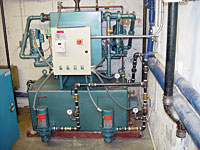
"It was costing us approximately $40,000 annually to heat the high school and another $14,000 to heat the elementary school," said Joe Cascone, facilities manager for the Church of Saint Mary.
Given the size of the two schools - 40,000 square feet and 18,000 square feet, respectively - no one could argue that fuel costs had gotten out of hand.
In both schools, the major source of inefficiency was poor distribution. It took 6 pounds of steam pressure to get steam to all the elementary school zones and 8 pounds to the high school zones. These high pressures resulted in longer run times on both boiler systems, increasing overall fuel consumption.
TYPICAL PROBLEMS
The problems at these two schools were typical of many facilities where aged steam systems still provide the primary source of heat. Invariably, over time, the ability of the system to efficiently deliver steam to all zones is impaired by faulty or poorly maintained traps and other distribution issues. Given these typical realities of older steam systems, the challenge is getting steam to flow quickly through the system without having to generate an inordinate amount of pressure.In this case, Ed and Frank Burke, of Burke Mechanical Corp. (Long Island, N.Y.), believed they had a solution: a vacuum condensate unit from HT Pump Specialties.
Burke Mechanical and Cascone were aware of the difference that a properly applied vacuum system could make to a facility's bottom line. Burke Mechanical had successfully applied such systems in the past and Cascone had experienced the transformation at a similar project while employed at another church. Both were eager to see what a vacuum system could do for St. Mary's.
A 120-gallon vacuum/boiler feed unit was selected for the combination oil/gas fired steam boiler system at the elementary school. The system is designed to maintain 8 to 10 in. of vacuum pressure at all times. As a safety measure, a Heat-Timer Digi-Span set point control was installed on the unit control panel, which is designed to deactivate the pumps if temperature sensors register that condensate temperatures are approaching high limit.
As a result, the elementary school now heats up much more quickly and is able to do so at one quarter the pressure, said Cascone. Since the boiler is operating less often, the school is paying noticeably less for fuel, he added.

NIGHT AND DAY
A similar system was applied to the high school steam system. A 36-gallon vacuum condensate system was selected for the steam system, which consists of two boilers. Because of space limitations, the high school system did not include a boiler feed tank. Otherwise, the system operates the same as the elementary school, with the Venturi valve assembly serving to create the vacuum in the system.Results at the high school have been even more dramatic, according to Cascone. Operationally, the school is able to maintain heat by running only one boiler at a time, and rotating them every two weeks, whereas before two boilers were required to meet demand. Additionally, the system now operates on a quarter-pound of steam - so small, said Cascone, that a vapor stat (calibrated in ounces) had to be installed just to be able to register the exact pressure.
According to authorities, boiler runtimes last approximately 18 minutes per hour, compared to the 40 minutes per hour runtimes of heating seasons past, and it takes only 15 minutes to get steam to all parts of the high school, whereas it once took two hours.

The difference is like night and day, according to the occupants and the mechanical staff at both schools. Comfort is up, while fuel usage and maintenance headaches are down.
"It's nice when you can go back to the board and show them the system you recommended is really working," said Cascone. "We've got the numbers now to do that."
Publication date: 04/17/2006

Report Abusive Comment